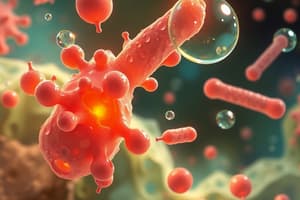Podcast
Questions and Answers
What is the suspected mechanism of action of clofazimine?
What is the suspected mechanism of action of clofazimine?
- Interfering with protein synthesis
- Inhibiting folic acid synthesis
- Inhibiting cell wall formation
- DNA binding (correct)
What is the half-life of clofazimine?
What is the half-life of clofazimine?
- 2 weeks
- 2 days
- 2 years
- 2 months (correct)
In which type of leprosy is clofazimine used?
In which type of leprosy is clofazimine used?
- Borderline leprosy
- Neuritic leprosy
- Lepromatous leprosy (correct)
- Tuberculoid leprosy
What is the main adverse effect of clofazimine?
What is the main adverse effect of clofazimine?
Why is pyrazinamide not used as a first-line treatment for TB in pregnant women?
Why is pyrazinamide not used as a first-line treatment for TB in pregnant women?
What is the purpose of giving pyridoxine to pregnant women with TB?
What is the purpose of giving pyridoxine to pregnant women with TB?
What is the mode of action of many antiprotozoal drugs?
What is the mode of action of many antiprotozoal drugs?
What is the treatment goal for intestinal amebiasis?
What is the treatment goal for intestinal amebiasis?
What is the purpose of treatment in asymptomatic intestinal amebiasis?
What is the purpose of treatment in asymptomatic intestinal amebiasis?
Which of the following drugs is used to treat intestinal amebiasis?
Which of the following drugs is used to treat intestinal amebiasis?
Flashcards are hidden until you start studying
Study Notes
Cell Wall Synthesis Inhibitors
-
Vancomycin:
- Bactericidal, inhibits cell wall synthesis
- Effective against Gram-positive organisms
- Pharmacokinetics:
- Administered by IV infusion, but given orally for antibiotic-induced pseudomembranous colitis
- Excreted renally, dosage adjusted in renal dysfunction
- Therapeutic uses:
- Oxacillin-resistant Staph aureus (ORSA)
- Serious allergy to penicillins
- Pseudomembraneous colitis following antibiotic use
- Adverse effects:
- Fever, rigors, and phlebitis
- Shock with rapid infusion (Red Man Syndrome) due to histamine release
- Hearing affection or loss
- Renal dysfunction
-
Bacitracin:
- Effective against Gram-positive organisms
- Restricted to topical application due to potential nephrotoxicity
Protein Synthesis Inhibitors
-
Tetracyclins (Tetracyclin, Doxycyclin, Minocyclin, Demeclocyclin):
- Mechanism of action: binding to 30S ribosomal subunit, inhibiting protein synthesis
- Therapeutic uses:
- Chlamydial infections
- Cholera
- Amoebiasis
- Acne vulgaris
- Mycoplasma pneumonia
- Meningococcal carriers
- Brucellosis
- Adverse effects and contraindications:
- Epigastric pain due to gastric irritation
- Teeth discoloration and bone hypoplasia (contraindicated in pregnancy, lactation, and children < 8 years)
- Hepatotoxicity
- Phototoxicity
-
Macrolides (Erythromycin, Clarithromycin, Azithromycin, Roxithromycin):
- Mechanism of action: inhibition of protein synthesis by binding to 50S bacterial ribosomal subunits
- Spectrum and uses of erythromycin:
- Drug of choice in patients with spirochetes or Gram-positive coccal infections with allergy to β-lactam antibiotics
- Drug of choice in urogenital chlamydial infection in pregnancy and mycoplasma pneumonia in children
- Adverse effects of erythromycin:
- Epigastric pain and intestinal colic
- Cholestatic jaundice (contraindicated in liver disease)
- Ototoxicity and transient deafness
- Thrombophlebitis if injected IV
-
Clindamycin & Chloramphenicol:
- Mechanism of action: binding to 50S ribosomal subunit, inhibiting protein synthesis
- Clindamycin:
- Used specifically against anaerobic infections
- Effective against Gram-positive organisms (Staph and Strept.)
- Used in bone infections due to good penetration into bones
- Adverse effects of clindamycin:
- Pseudomembraneous colitis
- Skin rash
- Diarrhea
- Liver dysfunction
- Chloramphenicol:
- Therapeutic uses:
- Typhoid fever (replaced by fluoroquinolones)
- Bacterial meningitis (H.influenza) + penicillin
- Topical use in eye infections (e.g., conjunctivitis)
- Anaerobic infections (e.g., anaerobic brain abscess)
- Adverse effects of chloramphenicol:
- GIT upset and superinfection
- Bone marrow depression (dose-independent or idiosyncrasy)
- Grey baby syndrome in neonates
- Optic neuritis
- Inhibition of hepatic microsomal enzymes (drug interaction)
- Therapeutic uses:
-
Clofazimine:
- Mechanism of action: unknown, possibly DNA binding
- Anti-inflammatory effect
- Absorption: variable from gut, given orally once daily
- Excretion: mainly in feces, storage in reticuloendothelial tissues and skin
- Half-life: 2 months, delayed onset of action (6 weeks)
- Clinical uses:
- Multidrug resistance TB
- Lepromatous leprosy
- Tuberculoid leprosy in patients intolerant to sulfones or with dapsone-resistant bacilli
- Chronic skin ulcers caused by M.ulcerans
- Adverse effects:
- Skin discoloration (red-brown to black)
- Gastrointestinal intolerance
- Red color urine
- Eosinophilic enteritis
Treatment of TB in Pregnant Women
- INH (with pyridoxine), Rifampicin, Ethambutol
- Pyrazinamide only if:
- Resistant to other drugs is documented
- Streptomycin is contraindicated
- Breastfeeding is not a contraindication, but caution should be observed
Antiprotozoan Drugs
- Protozoa are eukaryotic cells
- Many drugs are experimental, and their mode of action is unknown
Amoebiasis
- Infection with Entameba histolytica produced by ingestion of cysts
- In the intestine, cysts develop into trophozoites (active invasive form) which adhere to colonic epithelial cells
- Trophozoites lyse host cells and invade the submucosa, resulting in:
- Bowel lumen amoebiasis: asymptomatic, but cysts pass in the stool, transmitting infection to others
- Treatment is directed at eradicating cysts with luminal amebicidal drugs:
- Diloxanide
- Iodoquinol
- Paromomycin
- Tetracyclin
Studying That Suits You
Use AI to generate personalized quizzes and flashcards to suit your learning preferences.




